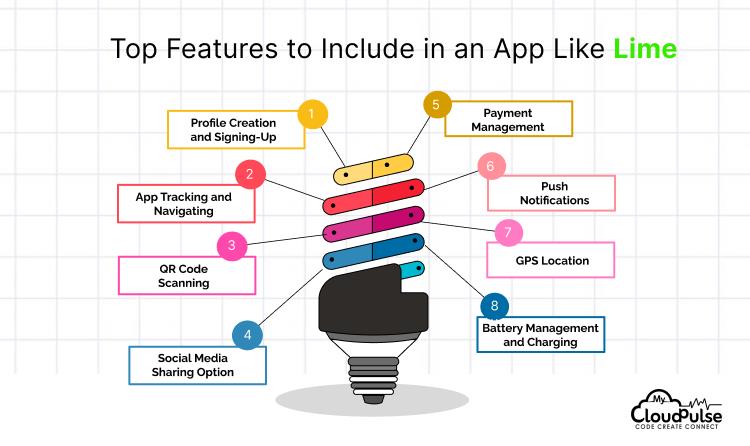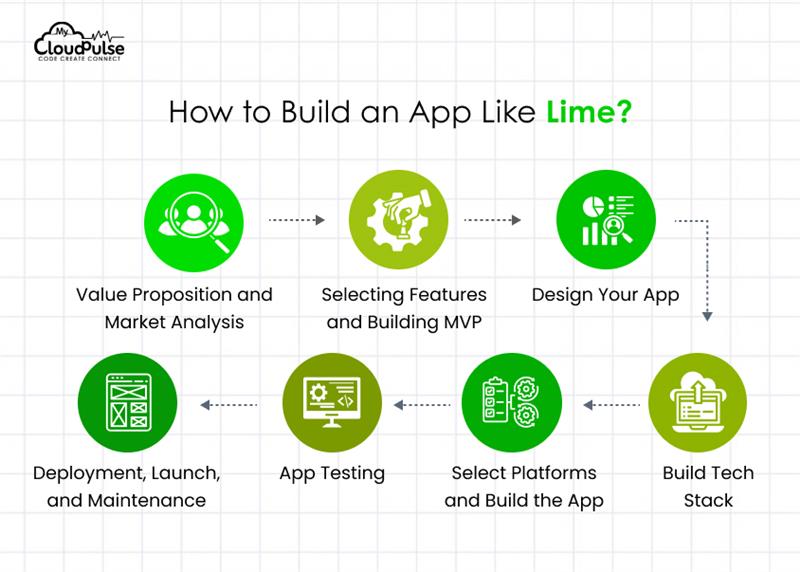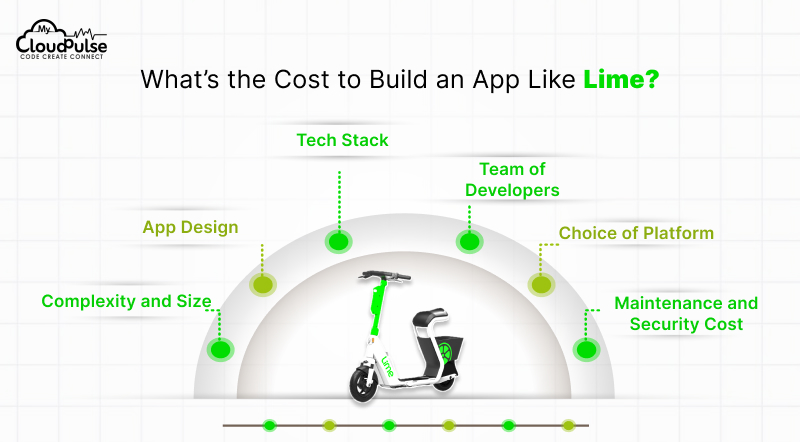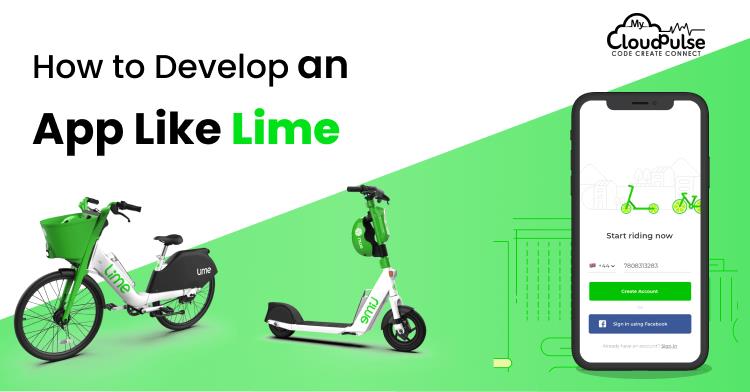Urban areas are always in motion. For shorter trips, people are looking for environmentally friendly, time-saving options. The rise of bike-sharing programs and electric scooters is directly attributable to this need. Lime is one of the most notable companies operating in this industry. Their app revolutionizes urban transportation and pleasure by connecting riders with easily accessible automobiles.
Anyone thinking about develop an app like Lime may find a comprehensive tutorial in this blog. We will go into the key elements that contribute to the success of such an application. The complexities of development will also be explored. In the end, we will give you a general idea of how much it will cost to launch your ride-sharing service.
Ride Green with Lime App
The foundation of Lime’s success story is the provision of a sustainable and hassle-free transportation option. You can rent electric scooters and bikes, find them, and pay for them all using their app. Their convenience and ease of use have made them a popular choice for shorter journeys, cutting down on the need for vehicles and the associated traffic problems.
Their vehicles’ distinctive lime green hue has become ubiquitous in cities throughout the globe, representing a movement toward more environmentally friendly modes of transportation. If you want to know how your app might benefit from Lime, you need to know what they provide.
Why Develop an App Like Lime?
There are several strong arguments in favor of creating a ride-sharing app like Lime.
1. Growing Market Demand
More and more people throughout the world are looking for micro-mobility options. The need for environmentally friendly and economically viable modes of transportation is rising in tandem with the urban population. For short to medium distances and in congested urban areas, electric bikes and scooters are a realistic transportation option. New competitors have a great chance to capitalize on this growing industry.
2. Source of Earning Revenue
You can make a ton of money with a well-made ride-sharing app. Users are mostly charged based on the length or distance of their rides. Making more money via in-app ads or forming partnerships might increase profitability even further.
3. An Eco-Friendly Measure
At a time when people are more concerned about the environment than ever before, electric bikes and scooters provide a cleaner alternative to vehicles. You may help reduce carbon emissions and promote sustainable urban mobility by offering a shared electric vehicle option in your app. This appeals to people who are concerned about the environment and may serve as a compelling selling feature.
4. Engaging Users
Users are more likely to stick with an app if it’s easy to use and has plenty of features. Loyalty programs, social sharing, and ride history are ways to make customers want to use your service again and again. Users’ everyday routines for short-distance travel are enhanced with an entertaining app.
5. Gets Rid of Parking Issues
In heavily populated cities, finding a parking spot may be a major pain. This is made easier by ride-sharing companies, who provide alternatives to docks, such as specific areas to store bikes and scooters. Users are drawn to these services mostly because of how convenient they are.
Top Features to Include in Ride Sharing Apps Like Lime
A ride-sharing app needs certain features to be effective.

1. Profile Creation and Signing Up
The acquisition of users is dependent on a simple and safe sign-up procedure. Profile creation should be a breeze, and users should be able to use their email, phone, or social network accounts. Data security and secure password management are of utmost importance.
2. App Tracking and Navigating
GPS tracking in real-time is essential. Users need to be able to see the current battery life and availability of scooters or bikes on a map. For a seamless experience, it is essential to provide clear navigation tools that lead customers to their desired vehicle and their destination.
3. QR Code Scanning
We need an unlocking mechanism that is both fast and dependable. Scanning a code on a scooter or bike with a smartphone camera makes unlocking the vehicle a breeze. We expect this procedure to go smoothly and efficiently.
4. Social Media Sharing Option
Promoting a service by letting customers discuss their rides on social media is a smart move. This not only keeps the users engaged with your app but also proves to be an effective source of marketing.
5. Payment Management
We must have a payment system that is both flexible and secure. Customers need to have the option to connect several payment methods, including digital wallets, credit cards, and debit cards. The app needs to make the cost of rides easy to see and pay for.
6. Push Notifications
An effective method of user engagement is the usage of push notifications. Promotions, local vehicle availability, low battery alerts, ride completion, and other relevant information may all be sent using these.
7. GPS Location
Users and the platform alike rely on precise GPS location services. To locate nearby vehicles, users’ locations are required, and monitoring and administration of vehicles rely on vehicle location data.
8. Battery Management and Charging
The app needs to provide the current battery life of any vehicle that is accessible. It is the responsibility of the system’s backend to optimize charging schedules, monitor which vehicles require charging, and maintain battery levels.
How Does an App Like Lime Work?
Here are the basic procedures that a user goes through while using ride-sharing software like Lime:
Step 1: Installation, Profile Creation, and Authorization
To begin, users must go to the app store on their mobile device, whether it is an iOS or Android device. After that, they fill up the profile with all the required details and confirm their agreement to the terms and conditions. This is the point, or just before the first ride, when payment details are often entered.
Step 2: Select Location and Enter Details
When users launch the app, a map displaying nearby automobiles is shown. They may locate a bike or scooter by navigating the map or using the search features. You may see information like the charge status and estimated rental.
Step 3: Book and Schedule
Depending on the capabilities of the app, users have the option to book a vehicle instantly or schedule it at a later time. By reserving the vehicle in advance, you may keep it from being used by others for a certain time.

Step 4: Unlock and Start Ride
When users reach the vehicle, they usually scan a QR code using the app. When you do this, the vehicle will open, and the journey will start. Once you begin riding, the app will begin to record the time and distance traveled.
Step 5: Enjoy the Ride and Pay
To go where they’re going, riders get on the scooter or bike. They arrive, park the vehicle in a certain spot (or as required by law) and then use the app to cancel the journey. After that, the software will figure out how much it will cost and charge the user.
How to Develop an App Like Lime?
It takes meticulous preparation and execution to complete each step of develop an app like Lime.

Step 1: Value Proposition and Market Analysis
Determining the app’s value proposition is an important first step before beginning development. In comparison to its rivals, what sets it apart? Find out who you’re selling to, how the competition stacks up, and what the rules are in your area by doing some serious market research.
Step 2: Selecting Features and Building MVP
Build your Minimum Viable Product (MVP) around its most important features. Zero down on the core features that customers really need in order to reserve, unlock, ride, and pay for a vehicle. Because of this, we can get customer input early on and deploy more quickly.
Step 3: Design Your App
The adoption and retention of users are directly related to the UX and UI. Make the administrative backend and the user-facing app both aesthetically pleasing and functionally sound. Think of things like aesthetics, information clarity, and ease of navigation.
Step 4: Build Tech Stack
Scalability, performance, and security are three aspects that must be carefully considered when choosing technology. All the way from selecting a database (PostgreSQL or MongoDB), location service (Google Maps Platform, for example), and payment gateway (Stripe or PayPal, for example), to deciding on a programming language (iOS: Swift, Android: Kotlin, Node.js or Python for the backend).
Step 5: Select Platforms and Build the App
Make a choice: build an app that works natively on iOS and Android or create a cross-platform app. Developing for two platforms independently may be costly and time-consuming, but native applications often provide superior performance. While cross-platform frameworks might help you save time and money, they may not provide the same level of speed or native feature access that you’re looking for.
Step 6: App Testing
To find and correct issues, make sure everything works smoothly, and maximize performance, rigorous testing is necessary. Unit testing, integration testing, UAT, and security testing are all part of this.
Step 7: Deployment, Launch, and Maintenance
Send your application to app stores when testing is over. Plan your launch with marketing and user acquisition in mind. The success of your program in the long run depends on regular maintenance, upgrades, and technical support.
What’s the Cost to Develop an App Like Lime?
The price tag for develop an app like Lime might vary greatly depending on a number of variables. If you want to budget well, you need to know these things.

1. Complexity and Size
The amount of money needed to create an app is proportional to its complexity and the amount of features it has. A feature-rich application with complex functions will cost more than a simple MVP with essential functionality.
2. App Design
The complexity of the app’s user interface and experience design affects the final price tag. Designing anything from scratch that looks good takes more time and skill than utilizing premade templates.
3. Tech Stack
The cost could change depending on the technology you choose. Developers with particular knowledge of certain frameworks and languages may charge more.
4. Team of Developers
The final price tag will be based on your development team’s size and location. If you care about quality, you must hire seasoned programmers, project managers, designers, and testers. There may be regional differences in development expenses as well.
5. Choice of Platform
It is often more costly to design a single cross-platform program rather than separate native applications for iOS and Android.
6. Maintenance and Security Cost
It is essential to provide funds for continuous upkeep, upgrades, server expenses, and security measures. These are ongoing expenditures that add up to the overall ownership cost.
Making an exact estimate is difficult without a comprehensive project scope, however based on the aforementioned considerations, the cost to create an app similar to Lime may vary anywhere from $50,000 to $300,000 or even more. One end of the range can be developing a minimal viable product (MVP), while the other end might be a large-scale, native software with all the bells and whistles.
How Much Time Is Required to Develop an App Like Lime?
Both the size and complexity of the project have an impact on the time required for development. It might take 4–8 months to produce a simple MVP, but 8–18 months or more to build a more feature-rich application. The amount of features, development methodology, and team size are some of the factors that influence the timetable.
Monetization Strategies For an Develop an App Like Lime
You can make money with a ride-sharing app in a few different ways:
1. Charging User’s Per Minute
For the most part, this is how such applications make money. The amount that users are charged depends on how long their ride lasts. Factors such as demand, time of day, and geographic region might affect prices.
2. In-App Advertisements
You may increase your app’s income by displaying appropriate adverts. Included in this category might be advertisements for services or companies in the area.
3. In-App Purchases
You may also generate income by charging for premium features or customization choices. Things like ride passes and user-defined app skins fall under this category.
4. Data Monetization
Businesses and urban planners alike may benefit from aggregated and anonymized user data, which includes things like most-used features and routes. While protecting users’ privacy, this data may be used to make money.
5. Partnerships and Sponsorships
Additional money and advertising possibilities may be obtained via collaborations with local companies or by procuring sponsorships.
6. Subscription Plans
One way to generate consistent income and encourage customer loyalty is to provide a subscription plan that allows customers to ride unrestricted for a certain length of time for a predetermined price.

Why Select MyCloudPulse for Building An App Like Lime?
If you want your idea for a ride-sharing app to become a reality, MyCloudPulse is the company to call. By keeping the customer in the loop and encouraging teamwork at every stage, our talented development, design, and project management team puts the client first. Custom, scalable, and secure apps tailored to your company’s requirements are what we specialize in developing. As a reliable collaborator on your project, we are well-versed in the intricacies of real-time tracking, connection with payment gateways, and location-based services.
Frequently Asked Questions
Answer: User profiles and registration, vehicle monitoring in real-time via maps, QR code scanning to unlock, secure payment integration, and push alerts are the most important features.
Answer: The complexity, features, design, and development team determine the cost, which may range from $50,000 to $300,000 or even more.
Answer: Project scope and development methodology determine the approximate duration of development, which may be anywhere from four to eighteen months or more.
Answer: Subscription plans, data monetization, in-app advertising, in-app sales, and charging users per minute are key techniques.
Answer: Backend languages like Node.js and Python, databases like PostgreSQL and MongoDB, and mapping services like Google Maps Platform are common technologies. Native mobile development frameworks like Swift and Kotlin for Android and iOS, as well as cross-platform frameworks like React Native and Flutter, are also common.


